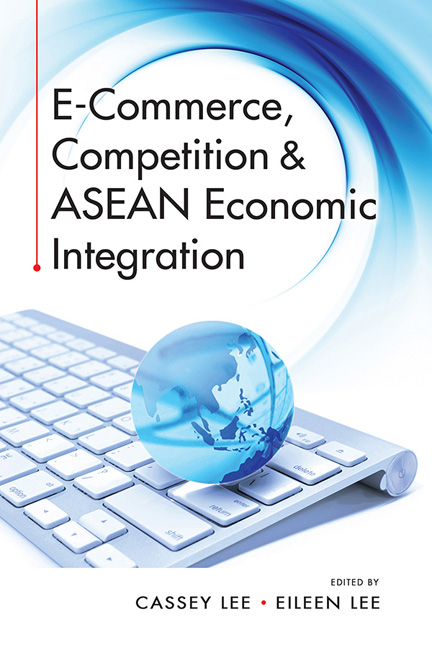Book contents
- Frontmatter
- Contents
- Acknowledgements
- About the Contributors
- 1 Introduction
- PART I
- PART II
- PART III
- PART IV
- 5 E-commerce and its Development in Thailand
- 6 E-commerce Development in Indonesia: Challenges and Prospects
- 7 Development of E-commerce in Malaysia
- 8 E-commerce in Singapore: Current State, Policies and Regulations
- 9 Competition and E-commerce in the Philippines
- 10 Vietnam: E-commerce Market Overview and Trends
- Index
6 - E-commerce Development in Indonesia: Challenges and Prospects
from PART IV
Published online by Cambridge University Press: 31 January 2020
- Frontmatter
- Contents
- Acknowledgements
- About the Contributors
- 1 Introduction
- PART I
- PART II
- PART III
- PART IV
- 5 E-commerce and its Development in Thailand
- 6 E-commerce Development in Indonesia: Challenges and Prospects
- 7 Development of E-commerce in Malaysia
- 8 E-commerce in Singapore: Current State, Policies and Regulations
- 9 Competition and E-commerce in the Philippines
- 10 Vietnam: E-commerce Market Overview and Trends
- Index
Summary
Introduction
In recent years, there have been both high expectations and stimulating development in e-commerce sector in Southeast Asia in general and in Indonesia in particular. High expectations come from both private and public sectors. For instance, Google-Temasek (2016) predicted that Southeast Asia will be the fastest growing internet market in the world (reaching around 480 million internet users by 2020). Moreover, they projected that Indonesia will become the fastest growing internet market in the world, with 19 per cent compound annual growth rate (CAGR) for the period of 2015–20. By 2025, Indonesia is expected to account for 52 per cent of e-commerce market in the Southeast Asian region. In addition to Google-Temasek's upbeat projection, McKinsey (2016) estimated that the value of the Indonesian e-commerce market will reach US$150 billion by 2025.
In November 2016, the Indonesian government released the 14th economic policy package, which aims to promote the country's e-commerce business environment. In this economic policy package, the government sets an ambitious target to create “1,000 technology entrepreneurs” with business valuation up to US$10 billion by 2020. Almost a year later, in August 2017, President Joko “Jokowi” Widodo signed a Presidential Regulation No. 74/2017 on the Roadmap for the National Electronic Commerce System 2017–2019 (Sekretariat Kabinet Republik Indonesia 2017). This regulation provides the required legal framework for e-commerce business operation in Indonesia.
Despite various upbeat projections on e-commerce prospect in Indonesia, there are many challenges facing the sector development in the country. Firstly, there is a limited pool of skilled workers trained in information and communication technologies (ICT) and in related fields, such as software engineers, coders, platform developers, and so on. Secondly, the internet penetration rate in the country is still low (at around 34 per cent), with internet speed still on the lowest end in the region (average 6.7 Mbps in 2016). Thirdly, the payment mechanism is still limited, also with more than 60 per cent of the population having no access to banking institutions. Fourthly, Indonesia's archipelagic-topographical structure creates additional challenge in terms of high logistical cost. This challenge is worsened by poor infrastructure and limited delivery options.
- Type
- Chapter
- Information
- E-Commerce, Competition and ASEAN Economic Integration , pp. 119 - 168Publisher: ISEAS–Yusof Ishak InstitutePrint publication year: 2019

